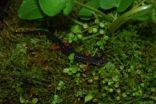(Press-News.org) AMHERST, Mass. – A collaborative team of scientists including biochemist Peter Chien at the University of Massachusetts Amherst has reconstructed how bacteria tightly control their growth and division, a process known as the cell cycle, by specifically destroying key proteins through regulated protein degradation.
Regulated protein degradation uses specific enzymes called energy dependent proteases to selective destroy certain targets. Because regulated protein degradation is critical for bacterial virulence and invasion, understanding how these proteases function should help to uncover pathways that can be targeted by new antibiotics.
All organisms use controlled degradation of specific proteins to alter cellular behavior in response to internal or external cues, says Chien, an assistant professor of biochemistry and molecular biology. And, a process that has to happen as reliably and stably as cell division also has to be flexible enough to allow the organism to grow and respond to its ever-changing environment. But little has been known about the molecular mechanics of how cells meet these challenges.
This work, done in collaboration with Kathleen Ryan and colleagues at the University of California, Berkeley, was supported by the NIH's National Institute for General Medical Sciences. Results appeared this week in an early online edition of Proceedings of the National Academy of Sciences.
Energy dependent proteases can be thought of as tiny molecular-level machines, says Chien. By selectively cutting and destroying key proteins at precise time points during cell division, they take charge of when, and at what rate, a cell grows and divides. They are found in all kingdoms of life, but are especially important in bacteria where they help cells overcome stressful conditions such as an attack by antibiotic treatment.
"When the environment becomes damaging, these proteases selectively target particular proteins to stop cell division so the bacteria can turn to focus instead on repair until the stress is over," Chien explains. "Understanding how bacteria use these machines at the cellular and molecular level could reveal avenues for discovery of new drugs to treat infectious diseases."
The researchers focused on the bacterium Caulobacter crescentus. The cell cycle for this bacterium is controlled by the destruction of key proteins such as the essential transcription factor known as CtrA, but until now it has been unclear how this actually worked at the molecular level. Researchers have known for more than 20 years that one of the factors important for this protein destruction is an energy dependent protease ClpXP.
But ClpXP is always present through the bacterial cell cycle, not always actively breaking down CtrA, suggesting that more complex regulation was going on. Further, more recent work showed that CtrA degradation requires changes in second messengers, small molecules that help different cell pathways communicate with each other. CtrA degradation also needs dephosphorylation of proteins known as adaptors, Chien notes.
His graduate student Kamal Joshi found that these additional proteins were needed to create a scaffold that linked the CtrA substrate to the ClpXP protease. Importantly, this scaffold had to bind the small molecule second messengers in order to hold CtrA and had to contain properly dephosphorylated adaptors in order to hold the ClpXP protease.
"By requiring both these inputs, the cell ensures that degradation of CtrA only occurs at a very specific time," Chien summarizes. "We show that three proteins work together as a multi-component adaptor to stimulate the degradation of CtrA in Caulobacter crescentus. The adaptor only functions when one of the components, CpdR, is unphosphorylated and when another component, PopA, is bound to the signaling molecule, cyclic diguanylate. All this ensures that CtrA is only broken down during a specific window in the bacterium's cell-division cycle."
Chien recently received a five-year, $1.4 million grant from NIH to further explore how bacteria deal with stress by destroying their own proteins. His future work should reveal new pathways that could be targeted to block bacterial virulence or to prevent bacteria from resisting the stresses produced by antibiotics now in use.
INFORMATION:
Knowing how bacteria take out trash could lead to new antibiotics
Because regulated protein degradation is critical for bacterial virulence and invasion, understanding how these proteases function should help to uncover pathways that can be targeted by new antibiotics
2014-09-04
ELSE PRESS RELEASES FROM THIS DATE:
Reacting to personal setbacks: Do you bounce back or give up?
2014-09-04
Sometimes when people get upsetting news – such as a failing exam grade or a negative job review – they decide instantly to do better the next time. In other situations that are equally disappointing, the same people may feel inclined to just give up.
How can similar setbacks produce such different reactions? It may come down to how much control we feel we have over what happened, according to new research from Rutgers University-Newark.
The study, published in the journal Neuron, also finds that when these setbacks occur, the level of control we perceive may even determine ...
Plant-based research at Penn prevents complication of hemophilia treatment in mice
2014-09-04
While healthy people have proteins in their blood called clotting factors that act quickly to plug wounds, hemophiliacs lack these proteins, making even minor bleeds difficult to stop.
The main treatment option for people with severe hemophilia is to receive regular infusions of clotting factor. But 20 to 30 percent of people who get these infusions develop antibodies, called inhibitors, against the clotting factor. Once these inhibitors develop, it can be very difficult to treat or prevent future bleeding episodes.
In a new study, researchers from the University of ...
LSU Health research discovers new therapeutic target for diabetic wound healing
2014-09-04
New Orleans, LA – Research led by scientists in Dr. Song Hong's group at LSU Health New Orleans has identified a novel family of chemical mediators that rescue the reparative functions of macrophages (a main type of mature white blood cells) impaired by diabetes, restoring their ability to resolve inflammation and heal wounds. The research is in-press and is scheduled to be published in the October 23, 2014 issue of Chemistry & Biology, a Cell Press journal.
The white blood cells, or leukocytes, of the immune system, help defend the body against infection or foreign ...
Study shows complexities of reducing HIV rates in Russia
2014-09-04
(Boston) – Results of a new study conducted in St. Petersburg, Russia, show that decreasing HIV transmission among Russian HIV-infected drinkers will require creative and innovative approaches.
While new HIV infections globally have declined, HIV rates remain high in Russia. This is due in large part to injection drug use and spread via heterosexual sex transmission. Alcohol use also has been shown to be related to risky sexual behaviors and sexually transmitted infections (STIs).
Published online in Addiction, the study showed that a behavioral intervention did not ...
AGU: Ozone pollution in India kills enough crops to feed 94 million in poverty
2014-09-04
WASHINGTON, D.C. – In one year, India's ozone pollution damaged millions of tons of the country's major crops, causing losses of more than a billion dollars and destroying enough food to feed tens of millions of people living below the poverty line.
These are findings /of a new study that looked at the agricultural effects in 2005 of high concentrations of ground-level ozone, a plant-damaging pollutant formed by emissions from vehicles, cooking stoves and other sources. Able to acquire accurate crop production data for 2005, the study's authors chose it as a year representative ...
Greener neighborhoods lead to better birth outcomes, new research shows
2014-09-04
CORVALLIS, Ore. – Mothers who live in neighborhoods with plenty of grass, trees or other green vegetation are more likely to deliver at full term and their babies are born at higher weights, compared to mothers who live in urban areas that aren't as green, a new study shows.
The findings held up even when results were adjusted for factors such as neighborhood income, exposure to air pollution, noise, and neighborhood walkability, according to researchers at Oregon State University and the University of British Columbia.
"This was a surprise," said Perry Hystad, an environmental ...
Scientists prove ground and tree salamanders have same diets
2014-09-04
Salamanders spend the vast majority of their lives below ground and surface only for short periods of time and usually only on wet nights. When they do emerge, salamanders can be spotted not only on forest floors but also up in trees and on other vegetation, often climbing as high as 8 feet. Given their infrequent appearances aboveground, it has never been clear to biologists why salamanders take time to climb vegetation. Researchers at the University of Missouri recently conducted a study testing a long-standing hypothesis that salamanders might climb vegetation for food. ...
Public trust has dwindled with rise in income inequality
2014-09-04
Trust in others and confidence in societal institutions are at their lowest point in over three decades, analyses of national survey data reveal. The findings are forthcoming in Psychological Science, a journal of the Association for Psychological Science.
"Compared to Americans in the 1970s-2000s, Americans in the last few years are less likely to say they can trust others, and are less likely to believe that institutions such as government, the press, religious organizations, schools, and large corporations are 'doing a good job,'" explains psychological scientist and ...
Researchers turn to plants to help treat hemophilia
2014-09-04
GAINESVILLE, Fla. — Accidents as minor as a slip of the knife while chopping onions can turn dangerous for patients with hemophilia, who lack the necessary proteins in their blood to stem the flow from a wound.
People with severe hemophilia typically receive regular injections of these proteins, called clotting factors, as a treatment for the disease. But up to 30 percent of people with the most common form, hemophilia A, develop antibodies that attack these lifesaving proteins, making it difficult to prevent or treat excessive bleeding.
Now, researchers from University ...
T. rex times 7: New dinosaur species is discovered in Argentina
2014-09-04
Scientists have discovered and described a new supermassive dinosaur species with the most complete skeleton ever found of its type. At 85 feet long and weighing about 65 tons in life, Dreadnoughtus schrani is the largest land animal for which a body mass can be accurately calculated.
Its skeleton is exceptionally complete, with over 70 percent of the bones, excluding the head, represented. Because all previously discovered super-massive dinosaurs are known only from relatively fragmentary remains, Dreadnoughtus offers an unprecedented window into the anatomy and biomechanics ...
LAST 30 PRESS RELEASES:
Estimating unemployment rates with social media data
Climate policies can backfire by eroding “green” values, study finds
Too much screen time too soon? A*STAR study links infant screen exposure to brain changes and teen anxiety
Global psychiatry mourns Professor Dan Stein, visionary who transformed mental health science across Africa and beyond
KIST develops eco-friendly palladium recovery technology to safeguard resource security
Statins significantly reduce mortality risk for adults with diabetes, regardless of cardiovascular risk
Brain immune cells may drive more damage in females than males with Alzheimer’s
Evidence-based recommendations empower clinicians to manage epilepsy in pregnancy
Fungus turns bark beetles’ defenses against them
There are new antivirals being tested for herpesviruses. Scientists now know how they work
CDI scientist, colleagues author review of global burden of fungus Candida auris
How does stroke influence speech comprehension?
B cells transiently unlock their plasticity, risking lymphoma development
Advanced AI dodel predicts spoken language outcomes in deaf children after cochlear implants
Multimodal imaging-based cerebral blood flow prediction model development in simulated microgravity
Accelerated streaming subgraph matching framework is faster, more robust, and scalable
Gestational diabetes rose every year in the US since 2016
OHSU researchers find breast cancer drug boosts leukemia treatment
Fear and medical misinformation regarding risk of progression or recurrence among patients with breast cancer
Glucagonlike peptide-1 receptor agonists and asthma risk in adolescents with obesity
Reviving dormant immunity: Millimeter waves reprogram the immunosuppressive microenvironment to potentiate immunotherapy without obvious side effects
Safety decision-making for autonomous vehicles integrating passenger physiological states by fNIRS
Fires could emit more air pollution than previously estimated
A new way to map how cells choose their fate
Numbers in our sights affect how we perceive space
SIMJ announces global collaborative book project in commemoration of its 75th anniversary
Air pollution exposure and birth weight
Obstructive sleep apnea risk and mental health conditions among older adults
How talking slows eye movements behind the wheel
The Ceramic Society of Japan’s Oxoate Ceramics Research Association launches new international book project
[Press-News.org] Knowing how bacteria take out trash could lead to new antibioticsBecause regulated protein degradation is critical for bacterial virulence and invasion, understanding how these proteases function should help to uncover pathways that can be targeted by new antibiotics




